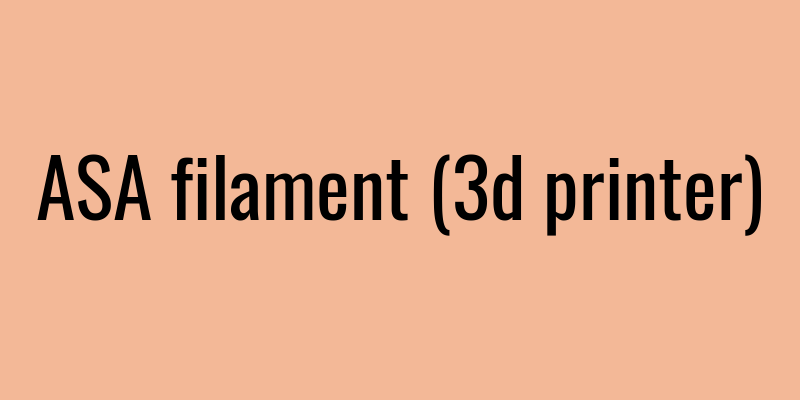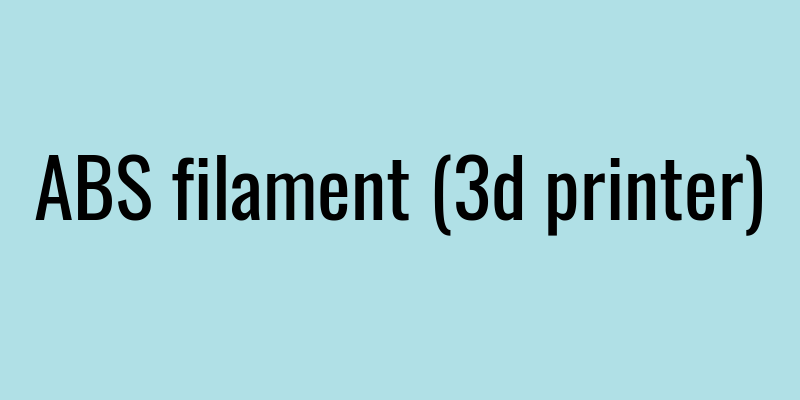Unlocking the Potential of ASA Filament: Pros and Cons Unveiled
Discover the hidden merits and drawbacks of using ASA filament in 3D printing.
ASA filament has emerged as a popular material for 3D printing enthusiasts and professionals alike. Known for its remarkable resistance to UV light and weathering, it is often used for outdoor applications and functional prototypes. But what exactly makes ASA stand out from other filament options? In this article, we will explore the many advantages and disadvantages of ASA filament, helping you make an informed choice for your next 3D printing project. Whether you’re a hobbyist or a professional, understanding ASA's properties can guide you in leveraging its strengths and mitigating any potential weaknesses.
With the rise in demand for durable and versatile materials in 3D printing, ASA filament has found its niche in applications where toughness and appearance matter. Many users have turned to ASA as a reliable alternative to ABS, appreciating its ease of use and reduced warping tendencies. However, like any material, ASA filament has its merits and pitfalls. In this comprehensive discussion, we aim to delve deep into what anyone interested in 3D printing should know about ASA filament, covering everything from its mechanical properties to its cost-factor implications.
Pros
Diving into the advantages of ASA filament reveals a material that is not only practical but also highly effective. There are several compelling reasons why manufacturers and makers are gravitating toward ASA for their 3D printing needs. Its unique properties set it apart as a top choice in various applications. Let’s explore the benefits that ASA filament brings to the table and understand why it might be the perfect fit for your next project.
Post-Processing Possibilities: Unlocking Creative Potential
One of the advantages of ASA filament is its amenability to various post-processing techniques. Users can sand, paint, or glue ASA prints effectively, expanding creative opportunities and enhancing aesthetics. This versatility means that designers and hobbyists can create customized finishes or refine their prints to achieve the desired look and feel without compromising on the material’s inherent strength and weather resistance. It's a great choice for both functional and artistic projects.
High Temperature Resistance: Suitable for Demanding Applications
ASA filament is known for its high temperature resistance, enabling it to perform well in applications that require stability under heat. This attribute makes it an attractive option for 3D printing functional parts that may encounter elevated temperatures, whether in automotive, aerospace, or electronics industries. Users can trust that ASA components will retain their shape and functionality, even in challenging thermal environments.
Exceptional Weather Resistance: A Game Changer!
One of the most significant advantages of ASA filament is its exceptional weather resistance. ASA stands for Acrylonitrile Styrene Acrylate and has been engineered to withstand exposure to sunlight, moisture, and temperature variations. This makes it an ideal choice for outdoor applications and products that will be subjected to various environmental conditions. Compared to its close counterpart, ABS, ASA offers better UV stability, meaning that objects 3D printed with ASA will retain their color and properties longer when placed outdoors, making it a preferred choice for users seeking longevity.
Easy To Print: A User-Friendly Option
ASA filament is designed with ease of use in mind. Its printing characteristics often mirror those of ABS, but with fewer challenges in terms of warping and curling. This can reduce the time and effort required in preparation and execution while allowing even those with less experience in 3D printing to achieve successful results. A consistent extrusion and good layer adhesion enhances print quality, ensuring that the final product meets desired specifications without excessive trial and error. For both beginners and seasoned users, ASA filament provides a favorable experience.
Strong and Durable: Perfect for Functional Parts
When it comes to the mechanical properties of 3D-printed parts, ASA does not disappoint. It offers toughness and strength, making it suitable for a wide range of applications, including functional prototyping, automotive parts, and industrial applications. The robustness of ASA allows for the production of durable items that can withstand mechanical stress, therefore increasing the usability in everyday life. With an impressive impact resistance and good tensile strength, products made with ASA can endure demanding conditions while still maintaining their structural integrity.
Low Moisture Absorption: Reliable and Consistent Printing
ASA filament has a low moisture absorption rate, which means it can maintain its properties and performance over time. This is particularly beneficial for users in humid environments where other filaments may absorb moisture and degrade. A filament that does not easily absorb moisture ensures better print consistency, fewer failures, and a higher-quality final product. This characteristic supports longer print runs and reduces the need for storage concerns, making ASA filament a dependable choice for both hobbyists and professionals.
UV Resistance: Ideal for Outdoor Applications
One of the standout benefits of ASA filament is its excellent UV resistance. This makes it an outstanding option for applications intended for outdoor use, such as automotive parts, garden tools, and signage. ASA can withstand direct sunlight without significant degradation, retaining its color and structural integrity over time. This quality helps ensure that printed objects do not fade or become brittle when exposed to harsh environmental conditions, providing peace of mind for users who require durability in outdoor settings.
Excellent Chemical Resistance: Durable Under Tough Conditions
ASA filament offers great chemical resistance, making it suitable for applications that involve exposure to harsh chemicals or solvents. This characteristic allows ASA prints to maintain their integrity and performance when used in environments where other materials may degrade or fail. Industries such as automotive or chemical processing can benefit significantly from this property, ensuring long-lasting and reliable components that withstand challenging conditions.
Missing a pro?
Let us know which pro you are missing!
Cons
Despite its many advantages, ASA filament is not without its drawbacks. Understanding these limitations is crucial for anyone considering its use, as the disadvantages may affect print quality, user experience, or even project viability. In this section, we will delve into the downsides associated with ASA filament, providing a balanced view that can help potential users make informed decisions regarding their 3D printing projects.
Higher Shrinkage Rate: Risks of Warping
Although ASA is known for its strong properties, it does come with a higher shrinkage rate during the cooling process compared to other filaments. This can increase the likelihood of warping or distortion, especially in larger prints. Users must take care to use proper bed adhesion methods, like heated beds or adhesive solutions, to combat this issue. The necessity for additional precautions may deter beginners or those unfamiliar with handling such materials, making this a significant drawback for certain users.
Cost Considerations: Is It Worth the Investment?
ASA filament is generally more expensive than standard options like PLA or even ABS. This can be a significant factor for users who are managing tight budgets or operating on a cost-per-print basis. While the durability and UV stability of ASA can justify the price for some applications, others may find it prohibitive, especially when they are exploring 3D printing as a hobby rather than a professional business. Users will have to weigh the benefits against the higher initial investment to determine if ASA meets their financial criteria.
Limited Color Availability: Aesthetic Drawbacks
While ASA filament is available in various colors, the range is not as expansive as that of PLA counterparts. For creators focusing on aesthetic qualities—such as intricate designs or colorful models—this limitation can be disappointing. A narrower color palette may hinder the creative process for some users, especially if matching colors or unique hues is an important aspect of their project. Those looking for vibrant variations might need to turn to other filament types, potentially sacrificing the beneficial properties of ASA.
Fumes and Ventilation: Safety Precautions Needed
ASA filament, while user-friendly, does emit fumes during the printing process that may be inhaled if proper precautions are not taken. These fumes can contain harmful chemicals, necessitating the need for good ventilation or air filtration systems in the workspace. Users who plan to print with ASA filament should be prepared to invest in safety measures, adding another layer of consideration to its use. It’s crucial to create an environment that minimizes exposure to any harmful particulates or odors, which can affect indoor air quality.
Limited Printing Temperature Range: Potential Print Challenges
While ASA filament is generally easy to print, it has a more limited printing temperature range compared to some other materials. Users must be vigilant about maintaining the recommended temperatures to prevent issues like warping or layer adhesion problems. Inconsistent temperatures could lead to reduced print quality or structural weaknesses in the final product. Therefore, before choosing ASA, users need to ensure their 3D printer can accurately manage the temperature requirements for successful prints.
Limited Availability of Specialty Grades: A Niche Material
While ASA is a great material overall, its availability of specialty grades may be limited compared to more commonly used filaments like PLA or ABS. This means that users looking for specific properties, such as enhanced toughness or increased flexibility, may find fewer options. Consequently, those in need of highly specialized applications may face challenges in sourcing the right type of ASA filament to meet their unique requirements.
Brittleness at Low Temperatures: Potential Performance Limitations
ASA filament can become brittle when exposed to low temperatures, which could affect its performance in colder environments. This characteristic might limit its usability in applications subjected to extreme temperature variations, where other materials like PLA or nylon may perform better. Users should consider the operating conditions of their projects to ensure that ASA's properties align with the expected performance requirements.
Longer Cooling Time: Impacts of Print Speed
Due to its composition, ASA filament generally requires a longer cooling time than some other filaments, which can influence print speed and overall efficiency. This longer cooling phase may lead to delays in the printing process or necessitate changes in workflow for users aiming for rapid prototyping. Understanding the cooling requirements is crucial for achieving optimal print quality and reducing the potential for defects.
Missing a con?
Let us know which con you are missing!
Conclusion
In summary, ASA filament offers a host of benefits such as exceptional weather resistance, ease of printing, and durability that can enhance your 3D printing projects significantly. However, users must also be mindful of the disadvantages, including higher costs, limited color choices, and safety precautions concerning fumes. By weighing the pros and cons, you can better determine if ASA filament is the right choice for your needs. As the technology continues to evolve, ASA's role in 3D printing will likely expand, paving the way for innovative solutions in various applications.
What do you think?
Do you think the pros outweigh the cons?







